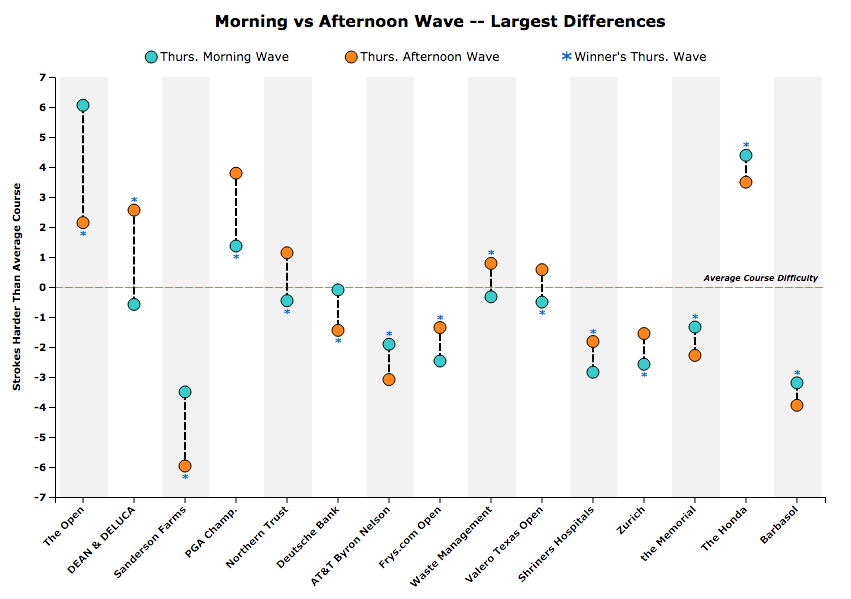Most people would agree that there is some luck involved in golf; a friendly kick off a tree, an untimely gust of wind, or one too many harsh lip outs can all affect a golfer’s score through no fault of their own. Despite the important role luck seems to play, it is, for the most part, hard to quantify.
In this article, we examine one component of luck on the PGA TOUR that is easily quantifiable: the differing course conditions between the morning and afternoon draws of a tournament. This allows us to make statements about who the luckiest, and unluckiest, players were on TOUR last year (with respect to the draws they received).
In most professional events, tee times on the first 2 days are put into a morning wave and an afternoon wave, usually separated by a couple of hours. If you are in the morning wave on the first day you will be in the afternoon wave on the second day, and vice versa. The same golf course can play drastically different at different times of the day; look no further than last year’s British Open for evidence of this (more on this later). This sometimes results in players being on the “wrong side of the draw”, and having to play a substantially harder course than half of the field. We analyzed 32 events on the PGA TOUR in 2016 to determine how much of an impact the draw has on the results of a tournament. (Only 32 events make our sample because some limited field events do not have a clear morning/afternoon distinction).
This first graph shows the biggest differences in (skill-adjusted) scoring averages between the morning and afternoon waves over the first 2 rounds in our sample of tournaments.

To understand the graph, consider the Open Championship in 2016. Over the first two rounds, the Thursday morning wave (i.e. playing round 1 in morning, round 2 in afternoon) played a course that was about 6 strokes harder than the average course in rounds 1&2 in 2016. The Thursday afternoon wave played a course that was only 2 strokes harder, resulting in a 4 stroke advantage over the first 2 days for the latter group. The winner was Henrik Stenson, who played in the Thursday afternoon wave, as denoted by the blue asterisk.
It’s worth noting that Jordan Spieth overcame the largest disadvantage due to the draw over the first two days; he won the DEAN & DELUCA Invitational from the Thursday afternoon wave despite playing a course that was more than 3 strokes harder than that faced by players in the Thursday morning wave.
Next, we determine how much certain players gained or lost over the year due to their series of draws throughout the season. The method is simple; we calculate each player’s strokes-gained relative to the field, and compare that to his strokes-gained relative to his tee-time wave (i.e. morning or afternoon). If a player gains more strokes over the field than he does over his wave throughout the year, than this means he was, on average, on the better side of the draw throughout the year. Clearly, as the number of events gets large, we would expect players’ strokes-gained over the field to be very close to his strokes-gained over their wave (as there should be no players systematically getting good or bad draws). Here are the numbers for 2016:

Let’s do a back-of-the-envelope calculation to evaluate the importance of these differences. In 2016, the relationship between a player’s strokes-gained average for the year, and his end-of-season FedEx Cup rank (before Playoffs start) is as follows: a 0.1 increase in strokes-gained per round is expected to result in approximately a 5-6 position increase in FedEx Cup rank. From the graph above, Louis Oosthuizen had the unluckiest draws throughout 2016; he lost 0.34 strokes per round over the first 2 days of tournaments due to his draw. Because golf tournaments are 4 rounds, the effect on Louis’ strokes-gained average for the year is (roughly) 0.34/2 = 0.17 strokes per round. Conversely, the luckiest player in 2016 was Zach Johnson, whose overall strokes-gained average was increased by 0.24/2=0.12 strokes per round by his series of tee time draws. Taken together, if Louis had been the luckiest player, instead of the unluckiest, he would have had a 0.3 stroke higher strokes-gained average for the year, which should roughly translate to an increase in FedEx Cup rank of about 15-18 positions (given that Louis was of mid-pack rank).
While most differences between players in their luck due to the draw are quite small, it was still the case that some players got dealt a bad hand. If we ever hear Louis complaining about his bad luck, we may be inclined to listen!

Excellent article. I’ve been calculating wave scoring for years; not every event but those that I’ve sensed were yielding a significant difference between waves. I’ve recently found a source that publishes it weekly… so there’s no need on my part anymore.
Generally when I’ve looked at wave differentials, for the most part I dismiss any result that yields less than a stroke total difference between the first 2 rounds. My thoughts are while it appears the PGA Tour specifically does a “decent” job of fairly equally distributing the talent between the waves, one can never be sure. A small handful of extra “Horses for courses” or players in better current form, or just happenstance of a group of players unexpectedly playing better/worse can greatly skew a wave difference
QUESTION: On the basis of the above… approx. what difference between waves would YOU start to conclude “there’s probably something here worth noting”. Would it be 1 stroke? More? Less?
Anyway… thanks again for the effort.